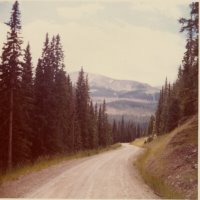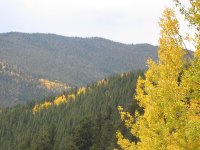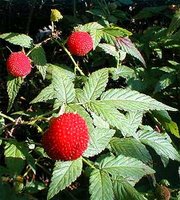Mountain Road

Some of the best drives are on mountain roads in the Colorado Rockies. The most interesting of these are the backcountry dirt-and-gravel byways that bob and weave through a beautiful variety of scenes.
One of these roads begins with an exit from a small paved highway in the foothills of north central Colorado. Immediately, the road leaves the sagebrush and hayfield environment and seems to disappear into a hidden small canyon. Beginning with the first sharp turn, seldom can the driver see more than a short distance of twenty or thirty yards of the road at a time, with many narrow and blind curves. A small stream runs parallel to the road, but can be viewed only in quick glances through the thick willow growth lining both the streambed and the roadbed. The road surface is hard-packed, but dusty, with washboard bumps that keep vehicle speeds to a slow pace. An occasional damp area, in deep shade, recalls a light rain shower from the previous day.
The willows grow thicker and taller, filling around an occasional ancient cottonwood tree, whose shiny dark green leaves twirling in the light breeze promise refreshing shade. The deep-grooved, rough bark of the sturdy cottonwood contrasts sharply with the smooth and lithe branches of the willow. Both plants advertise the presence of water, a welcome sign in a dry land.
The road often narrows to hardly more than a lane in width, but two vehicles can usually meet safely, with care. The maintenance crew has graded small pull-offs whenever possible, each just large enough for one vehicle to stop out of traffic’s way.
Traveling upstream, the road begins to climb in elevation, hardly perceptible at first. Suddenly, one of the sharp curves in the road completely doubles back on itself, creating a hairpin turn and a steep incline. The road gains altitude quickly. With the increasing elevation, the road leaves the stream, and the vegetation near the road changes dramatically. Willows and cottonwoods give way to pine and spruce. The forest becomes thick, and individual tree trunks are visible only a short distance into it.
Switchbacks occur more frequently, and the roadbed sees little sunshine through the tall trees growing immediately next to the road. Eventually, the evergreen forest begins to thin, and aspen groves become common. The aspen’s white trunks and light green leaves reflect more sunlight toward the road. Green grass and colorful wildflowers decorate the aspen glens. A tiny snow-fed brook passes under the road, with miniature waterfalls on both sides. The road continues to climb and becomes rougher and more narrow. A striped ground squirrel darts in front of the vehicle and dives into a hole in the rocky slope beside the road. Eventually, the aspen trees give way to limber pines stunted and gnarled by the harsh high-altitude environment. Soon, no trees survive, and the long-bladed grass has been replaced with tundra and lichen-covered rocks; the road is above timberline. In the absence of shade, the sun and sky seem exceedingly brilliant, and a light breeze feels downright cold, even in the middle of summer.
In a dozen miles of twists and turns, the road has risen six thousand feet in altitude. The ecology of the roadside has changed noticeably several times. The view from the top of the high mountain pass is breathtaking, an experience enhanced by the crisp, thin air. The excursion was challenging and tiring, but worth every moment of effort and careful attention. No other short drive compares to this small mountain road in the Rockies.
Gerald McDaniel, September 2006





